The problem is with the way you're redirecting the user to login route after the registration. You're falsely assuming that the $request data will be accompanied with the redirect.
Let's assume this scenario: A request gets dispatched to the postRegister method with name, email and password fields. The controller creates the user and saves it into the database. Then it redirects the user, who is not yet authenticated, to the login route. The postLogin method gets triggered, but this time with no request data. As a result, Auth::attempt($credentials) fails and you get that nasty Failure on screen.
If you add a dd($credentials) right after you create the array, you'll see that it has no values:
public function postLogin(Request $request)
{
$credentials = [
'username' => $request['username'],
'password' => $request['password'],
];
// Dump data
dd($credentials);
if (Auth::attempt($credentials)) {
return redirect()->route('dashboard');
}
return 'Failure';
}
It will return something like this:
array:2 [
"username" => null
"password" => null
]
You cannot redirect with custom request data (unless with querystring which is part of the URL), not matter what. It's not how HTTP works. Request data aside, you can't even redirect with custom headers.
Now that you know what's the root of your problem, let's see what are the options to fix it.
1. Redirect with flashed data
In case you want to preserve this structure, you need to flash the request data of postRegister() into the session (which is persistent between requests) and then retrieve it in the postLogin() method using Session facade, session() helper or the actual Illuminate\Session\SessionManager class.
Here's what I mean:
(I slightly modified your code; dropped extra variables, made it a lil bit cleaner, etc.)
public function postRegister(Request $request)
{
// Retrieve all request data including username, email & password.
// I assume that the data IS validated.
$input = $request->all();
// Hash the password
$input['password'] = bcrypt($input['password']);
// Create the user
User::create($input);
// Redirect
return redirect()
// To the route named `login`
->route('login')
// And flash the request data into the session,
// if you flash the `$input` into the session, you'll
// get a "Failure" message again. That's because the
// password in the $input array is already hashed and
// the attempt() method requires user's password, not
// the hashed copy of it.
//
->with($request->only('username', 'password'));
}
public function postLogin(Request $request)
{
// Create the array using the values from the session
$credentials = [
'username' => session('username'),
'password' => session('password'),
];
// Attempt to login the user
if (Auth::attempt($credentials)) {
return redirect()->route('dashboard');
}
return 'Failure';
}
I strongly recommend you against using this approach. This way the implementation of postLogin() method which is supposed to be responsible to login users gets coupled with session data which is not good. This way, you're not able to use postLogin independently from the postRegister.
2. Login the user right after the registration
This is a slightly better solution; If you decided that you need to log in the user right after the registration, why not just doing that?
Note that Laravel's own authentication controller does it automatically.
By the way, here's what I mean:
(Ideally this should be broken down into multiple methods, just like Laravel's own authentication controller. But it's just an example to get you started.)
public function postRegister(Request $request)
{
$input = $request->all();
$input['password'] = bcrypt($input['password']);
User::create($input);
// event(UserWasCreated::class);
if (Auth::attempt($request->only('username', 'password'))) {
return redirect()
->route('dashboard')
->with('Welcome! Your account has been successfully created!');
}
// Redirect
return redirect()
// To the previous page (probably the one generated by a `getRegister` method)
->back()
// And with the input data (so that the form will get populated again)
->withInput();
}
But still, it's far from perfect! There are many other ways to tackle this. One could be using events, throwing exceptions on failure and redirecting using custom exceptions. But I'm not gonna explore them as there's already a solution perfectly designed for this.
If you want to write your own authentication controller, that's fine. You'll learn a lot along the way. But I strongly suggest reading Laravel's own authentication code, especially RegistersUsers and AuthenticatesUsers traits in order to learn from it.
And one more note; you don't need that Illuminate\Auth\Authenticatable trait in your User model as it's already extending Authenticatable which use that trait.

